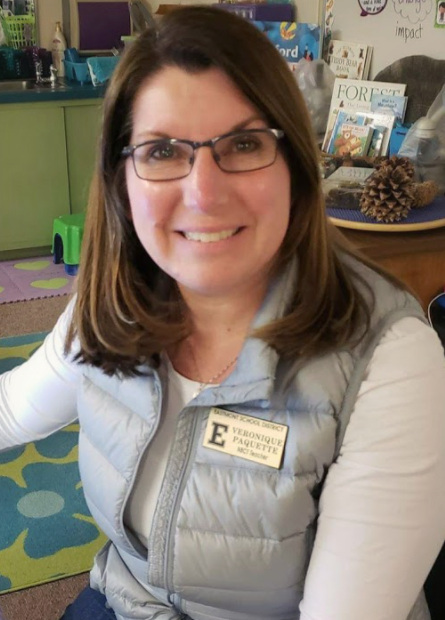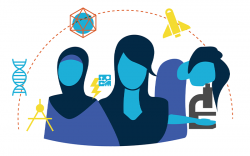Get to know Véronique Paquette – Teacher, STEM Advocate, and Notable Woman in STEM
Meet Véronique Paquette, second grade teacher, STEM advocate, and our latest Notable Woman in STEM. Véronique champions science in and outside of the classroom and helps foster a love of science in students and adults alike through her work with the NASA educator program and in the classroom at Kenroy Elementary in Wenatchee, WA.
How have you grown and changed as a teacher who emphasizes science and STEM? (What has your professional journey been as a teacher and STEM advocate?)

I currently teach second grade in Wenatchee, Washington, and have been teaching for 33 years at this point. When I was first starting as a new kindergarten teacher, I was looking for new and exciting ways to organize curriculum and engage students. I found myself working on a school district committee that was focused on science adoption. Through that process, I was introduced to a Northwest Educational Service District (ESD) science coordinator. That science coordinator became a role model for me, and his love and passion for science ignited something in me. I went back to my classroom with a renewed vision of how I wanted to teach my students, and it was around the world of science. My goal was to bring as much science from the outside world to my classroom in the most hands-on way I could.
After a few years, I moved to teach second grade and began implementing some of the best practices I learned in kindergarten. I realized that if I used science as my catalyst to teach reading, writing, and math, the whole world was open to what was possible in terms of teaching and learning. I found myself on more and more district science committees and ESD committees, I started working more closely with my colleague Jack Horne at the Northwest ESD, and began teaching other teachers how to incorporate science into the classroom. We traveled across the U.S. to present our work at conferences and events and saw great engagement and success with what we were showing our fellow educators. As I continued to learn and share more about science education, other opportunities kept coming my way. I began to work with NASA as a NASA educator. I worked at the U.S. Space and Rocket Center as a staff member in the Summer to focus on teacher education programs. I continue to provide science and technology training in my district.
What was your education and/or career path? How did you get where you are now?
My career path as an educator began in my childhood through my camping trips with my family. As a kid, my brother, my dad, and I would look up at the night sky to see constellations, falling stars, and all the other delightful things one can find if they just look up at night. That experience fostered this desire to understand the natural world around me. As I went through junior high and high school, I loved science, but I was a little scared of it and wasn’t sure if it was something I could do. I wanted to be a marine biologist, but the science didn’t come easily to me, even though I really wanted to understand it.
As I completed high school, I still wanted to be a marine biologist. But I also learned that I really loved working with children and ultimately decided to pursue teaching as my career. The irony is that despite not following that marine biology path, I found my way back to science through teaching. I learned that science is attainable for everyone, and job titles aren’t the only thing that makes you a scientist. Children are natural scientists, their curiosity knows no bounds, and they are born asking the question “why”? As a teacher, I want to show students that science is everywhere, and I’m grateful for the path that got me here. I had so many wonderful science teachers growing up that helped me learn to love science, and I wanted to do the same for others.

What would you like to say to young women thinking about beginning a career in STEM?
I would tell them to jump in and look back later. Never let any barrier keep you from pursuing STEM. Don’t question yourself and jump in with both feet; your desire and interest to pursue STEM shouldn’t be something you doubt. There may be some fear in the unknown, but you can harness that. That fear can help pull you through and get you where you want to be.
What/who were some of the most important influences that guided you to STEM and teaching?
First and foremost would be my dad. He instilled that love of the natural world in me. There’s something about instilling the passions you have into your own children that I find so very meaningful and this is a big reason why I do what I do. After my father, I look to all of the science teachers I’ve had in my life. I still remember every single one of their names and the impact they had on me. The excitement they had for teaching came through for me. Beyond the teachers that I’ve had, so many of the individuals I’ve met and formed relationships within my own ESD and in my community have been inspirational. The passion and excitement of those around me inspire me and have shaped who I am and how I teach.
What is your favorite part of your job?
Many years ago, as we approached the end of the year focused on our last science unit, one of my students had begun to pick up on how I was working to bring together different pieces of the natural ecosystem of apple orchards into our lesson. I knew that to understand apples and their ecosystem, you have to understand the importance of insects. And as I was setting up my final lesson to weave these concepts together, a student exclaimed, “You planned this!” He had begun to see all the connections between insects, fruit, and the natural world, which is precisely what I was hoping would happen. As a teacher, there is nothing that will ever replace that moment. It was the highest form of thinking, to connect those dots, and for my seven and eight-year-old students to make those connections on their own, there’s nothing more incredible to me.
What do you consider your most significant achievement as a teacher and STEM advocate?
If I were to sum it all up, the most significant thing has been the gift of being the tiny spark that helps light the fire for a love of science in kids, teachers, and other adults. Getting students and adults alike to see that there’s always something more that they can learn and do has been a real achievement for me.
Are there any stereotypes in STEM you’d like to personally dispel?
Everyone should see themselves as a scientist. Even as young as second grade, kids have certain notions about what a scientist is and what they look like. Many of the scientists they’ve seen up to that point have most likely been people like Einstein – crazy hair, absent-minded, and with lab coats. But I start every year dispelling that notion. It doesn’t matter what you look like or how you dress. As soon as you ask the question “why,” that makes you a scientist, which means anyone can be one if they want to be. As a teacher, modeling and exposure to a broad range of scientists are essential for students seeing themselves in STEM.
How do you see science, technology, engineering, and/or math working together in your role as a teacher?
These subjects pretty much guide everything I do every day. My teaching revolves around science content. I have spent my whole career working to use science as a vehicle for other topics, but I can’t do it with science alone. I have to have the investigation and problem-solving skills of an engineer. As I teach, my students need the math skills required to assess information and data to draw conclusions. Without technology, we wouldn’t have the tools to create daily snapshots of projects for data gathering. STEM touches on everything I do. I don’t know how to teach without it.